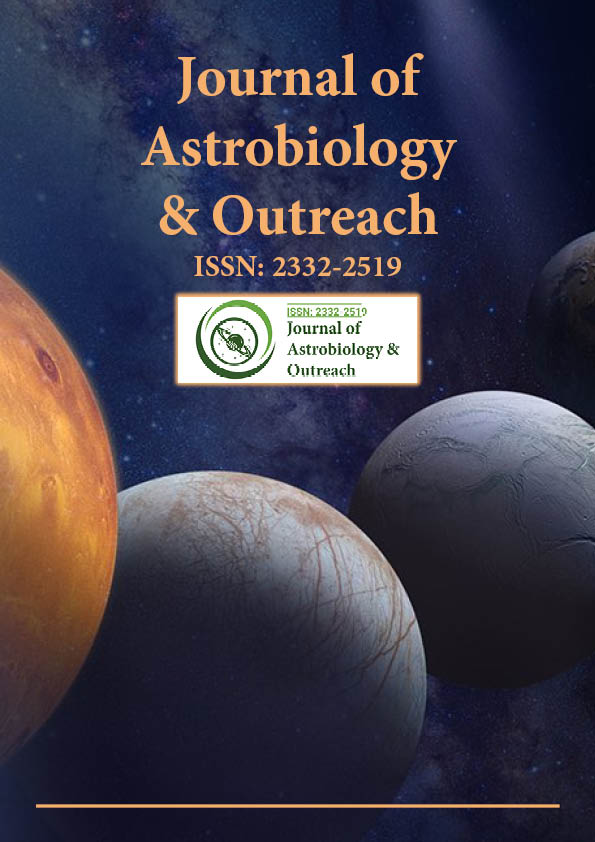Indexed In
- Open J Gate
- Academic Keys
- JournalTOCs
- RefSeek
- Hamdard University
- EBSCO A-Z
- OCLC- WorldCat
- Google Scholar
Useful Links
Share This Page
Journal Flyer

Open Access Journals
- Agri and Aquaculture
- Biochemistry
- Bioinformatics & Systems Biology
- Business & Management
- Chemistry
- Clinical Sciences
- Engineering
- Food & Nutrition
- General Science
- Genetics & Molecular Biology
- Immunology & Microbiology
- Medical Sciences
- Neuroscience & Psychology
- Nursing & Health Care
- Pharmaceutical Sciences
Perspective - (2023) Volume 11, Issue 5
Cosmic Catalysts in Astrophysics: Phenomena and Mechanisms
Fanny Chu*Received: 22-Aug-2023, Manuscript No. JAO-23-24781; Editor assigned: 25-Aug-2023, Pre QC No. JAO-23-24781(PQ); Reviewed: 08-Sep-2023, QC No. JAO-23-24781; Revised: 15-Sep-2023, Manuscript No. JAO-23-24781(R); Published: 25-Sep-2023, DOI: 10.35248/2332-2519.23.11.315
Description
Astrophysics, the study of celestial phenomena on a grand scale, explores the vast expanse of the cosmos, seeking to resolve the unexplainable of the universe. Central to this exploration are the cosmic catalysts phenomena and mechanisms that drive the dynamic processes shaping the cosmos.
One of the most fundamental cosmic catalysts is stellar nucleosynthesis, the process by which stars forge elements through nuclear reactions in their cores. Stars, those celestial furnaces, initiate nucleosynthesis by fusing lighter elements like hydrogen and helium into heavier ones, releasing energy in the process. This cosmic alchemy not only powers the stars but also produces a rich blend of elements, scattering them into space through stellar winds and explosive supernova events.
The birth, life, and death of stars are integral stages in stellar nucleosynthesis. Young stars, like our Sun, initiate hydrogen fusion in their cores, converting it into helium and releasing radiant energy. As stars age and exhaust their nuclear fuel, they progress through successive stages of fusion, creating heavier elements like carbon, oxygen, and iron. The explosive death throes of massive stars during supernovae unleash a torrent of elements, seeding the cosmos with a diverse array of building blocks important for the formation of planets and life.
In the cosmic ballet of celestial bodies, black holes emerge as gravitational catalysts of unparalleled power. These enigmatic entities possess such intense gravitational forces that not even light can escape their grasp. As matter spirals into a black hole's event horizon, it releases enormous amounts of energy in the form of gravitational waves and powerful jets of radiation. These cosmic phenomena shape the surrounding space, influencing the trajectories of nearby objects and altering the very fabric of the cosmos.
Black holes also play a significant role in galactic evolution. They can act as gravitational anchors, shaping the distribution of stars and gas within galaxies. The immense gravitational influence of supermassive black holes at the centers of galaxies is believed to regulate the growth of galaxies and control the dynamics of galactic structures.
Galactic collisions stand as dramatic cosmic events that propel astrophysical processes into motion. When galaxies, vast collections of stars, gas, and dust, interact and collide, their gravitational forces initiate a cosmic dance that shapes the destiny of celestial bodies within them. These collisions can trigger bursts of star formation, leading to the creation of new stars and planetary systems.
The interaction between galaxies also fuels the growth of supermassive black holes at their centers, resulting in the release of intense radiation and energetic particles. These dynamic cosmic collisions provide astronomers with a unique laboratory to study the effects of gravity, magnetic fields, and radiation on the evolution of galaxies and the formation of exotic objects.
Cosmic rays, high-energy particles originating from various astrophysical sources, serve as messengers from the cosmos, delivering valuable insights into the energetic processes occurring within it. These particles, including protons and atomic nuclei, travel at near-light speeds and can have a profound impact on the matter they encounter.
Supernova explosions, pulsars, and active galactic nuclei are among the cosmic catalysts producing cosmic rays. As these particles traverse the vast distances of interstellar space, they interact with magnetic fields and other particles, influencing the dynamics of cosmic environments. The study of cosmic rays focus on the energetic processes occurring within galaxies and provides a unique avenue for understanding the cosmic accelerators responsible for their production.
The cosmos harbors enigmatic forces in the form of dark matter and dark energy, two cosmic catalysts that exert gravitational influences on the evolution of the universe. Dark matter, although invisible and elusive, constitutes a significant portion of the total mass in the universe. Its gravitational effects shape the distribution of galaxies and galaxy clusters, acting as an unseen cosmic scaffolding that influences the formation and structure of cosmic structures.
On the other hand, dark energy, an unexplainable force driving the accelerated expansion of the universe, remains one of the most profound cosmic. The interplay between dark matter and dark energy dictates the large-scale structure of the cosmos, influencing the fate of galaxies and the overall geometry of the universe.
In the vast cosmic theater, cosmic catalysts serve as the agents of change, propelling the complex of celestial bodies and shaping the very fabric of the universe. From the nuclear furnaces within stars to the gravitational behemoths of black holes, and the elusive forces of dark matter and dark energy, these phenomena and mechanisms paint a rich blend of astrophysical wonders.
As astronomers and astrophysicists continue to resolve the complexities of cosmic catalysts, new discoveries await, providing insights into the mechanisms controling the universe's evolution. The study of these catalysts not only deepens our understanding of astrophysics but also opens avenues for contemplating the profound unexplainable that basically our cosmic existence. The exploration of cosmic catalysts remains a captivating drive into the unknown, where each revelation expose another layer of the cosmic narrative, inviting us to contemplate the grandeur of the cosmos and our place within it.
Citation: Chu F (2023) Cosmic Catalysts in Astrophysics: Phenomena and Mechanisms. J Astrobiol Outreach. 11:315.
Copyright: © 2023 Chu F. This is an open-access article distributed under the terms of the Creative Commons Attribution License, which permits unrestricted use, distribution, and reproduction in any medium, provided the original author and source are credited.

